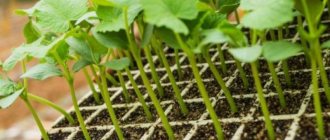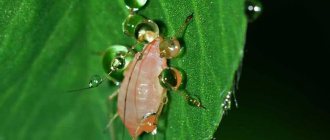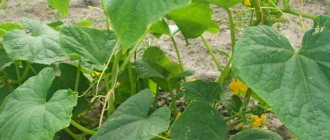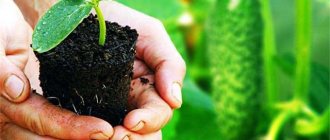Timing for sowing seeds for seedlings
Cucumbers are a heat-loving crop, and in order to grow high-quality seedlings you cannot do without reliable plant shelter. This is especially true for areas with cool climates. The exception is the southern regions, where you can grow cucumbers in open ground without shelter. To obtain an earlier harvest, the seedling method is also used here. In any case, the period for growing seedlings is quite short - about a month passes from the first shoots to the appearance of 2-3 true leaves.
For southern regions
Open ground
In the south, cucumbers can be planted in the ground even with dry seeds; here both early and late varieties and hybrids grow well. Many gardeners use planting at different times to get a harvest throughout the warm season. To grow the first, earliest harvest of greens, you need to grow seedlings at home on a windowsill. In this case, they begin to sow seeds in seedling containers in mid-April.
Greenhouse or greenhouse
In heated greenhouses with the ability to heat the soil and provide additional lighting for plants, cucumbers in the south can be grown all year round. Gardeners in private backyards and summer cottages can grow cucumbers in solar-heated greenhouses. In this case, sow the seeds in cups or cassettes for seedlings in the first ten days of March.
For the middle band
Open ground
Despite the fact that cucumber is a heat-loving crop, in the middle zone it has more comfortable growing conditions. The fact is that already at a temperature of +35°C cucumbers begin to experience stress, and +40°C is a critical temperature for them. In the Moscow region and the entire central zone, summers are rarely so hot, which has a good effect on plants. In these regions, seedlings can be planted in the ground starting from the 1st decade of June. This means you need to start growing it at home in mid-April.
Greenhouse or greenhouse
For heated greenhouses, the time for sowing seeds for seedlings is determined depending on how expensive the cucumber turns out to be. After all, the sooner the greenhouse starts working, the shorter the daylight hours, which means both heating and lighting need to be turned on earlier, and these are additional costs. Let's say that the greens are planned to be received for the holiday on March 8th. Early varieties begin to bear fruit 45 days after planting the seedlings. This means it needs to be planted around mid-January. Now we calculate when the seeds need to be planted in cups - this is approximately mid-December. Seedlings begin to be prepared for an unheated greenhouse around the end of March - mid-April.
For the Urals and Siberia
Open ground
The climatic conditions of these regions are characterized by cool, short summers. In open ground, early varieties are grown here only by seedlings. Before the first ten days of June, planting seedlings in open ground is dangerous not only because of the threat of return frosts, but also because of the cold, unheated soil. They begin sowing seeds in seedling containers in early May.
Greenhouse or greenhouse
The approximate time frame for starting work with seedlings for a greenhouse or greenhouse is the same as for the Moscow region. Summer here is even shorter, which means greenhouse costs also increase. Given this, many gardeners prefer to grow cucumbers closer to the warm season. Seedlings of early or ultra-early varieties are planted in greenhouses.
How to plant correctly
The agricultural technology for growing cucumbers in open ground has some peculiarities.
Selecting a site for planting
Cucumbers prefer well-lit, sunny areas protected from cold northern winds. South-eastern and south-western slopes are suitable. If the area is flat, planting tall crops can be used as protective fences: corn, Jerusalem artichoke, sunflowers, legumes. Creating hedges will increase the temperature by 2-3 degrees and maintain a favorable microclimate.
Expert opinion
Stanislav Pavlovich
Gardener with 17 years of experience and our expert
Ask a Question
Cucumbers require light, loose soil with neutral acidity or slightly alkaline (pH 6.2-6.8). Plant growth is inhibited in acidic and waterlogged soils. Indicators of high acidity can be weeds such as horsetail, horse sorrel, mint, bearberry, and moss. The soil must have good air exchange and moisture permeability. The best soils for growing cucumbers are light loamy, well-seasoned, with high microbiological activity.
Preparing soil and beds
Soil preparation begins in the fall by removing tops, plant residues and debris. If time permits, sowing green manure can be used to improve the soil composition. Cucumbers are demanding on nutrition and the best fertilizer for them is organic. During the autumn digging of the soil, rotted cow, horse manure or bird droppings are added. Per 1 m2 you will need 4-6 kg of mullein. The application rate of bird droppings is 2-3 times lower. Digging of the soil is carried out to a depth of 20-25 cm and high ridges are prepared. Refilling with organic matter not only provides plants with the necessary nutrients. The process of rotting manure produces carbon dioxide, which saturates the roots and increases the temperature of the soil.
In the spring, the soil is loosened and, if necessary, before planting, the soil is watered with an aqueous solution of mullein (1:5), chicken manure (1:20) or complex mineral fertilizer. The holes for planting are prepared several days before planting, and the soil is well moistened.
Advice! An effective fertilizer for cucumbers is wood ash. It not only supplies plants with readily available potassium, phosphorus, macro- and microelements, but reduces soil acidity.
Planting schemes
It is very important to place the plants correctly in the garden bed, since planting too sparsely reduces the efficiency of land use. Thickened plantings:
- impair lighting and air exchange;
- contribute to the development of diseases and pests;
- create conditions for the development of putrefactive processes;
- reduce flowering and fertilization.
Expert opinion
Stanislav Pavlovich
Gardener with 17 years of experience and our expert
Ask a Question
To grow cucumbers in open ground, traditional planting schemes are used, which depend on the variety, the climbing ability of the plant, its requirements for lighting, space and the method of forming the vines. The general rule for planting density is to place no more than 3-4 bushes per 1 m2.
Rows
Most often, in open ground, the classic single-line or row method of planting seedlings is used. It is necessary to plant plants in a row at a distance of 20-30 cm from each other so that the bushes do not shade each other. The same scheme is suitable for vertical cultivation in greenhouses and open ground. Weakly climbing varieties and hybrids can be grown with a row spacing of 70-80 cm.
Belt method
The method of planting with ribbons of two parallel rows or a two-line method is used. The distance between rows in a line is from 40 to 60 cm, and between ribbons - 80-150 cm. Plants can be planted in a row at a distance of about 40 cm.
Square nest system
With this planting scheme, holes for planting are prepared at a distance of 60 to 70 cm, both in the row and between the rows. This method is usually used when growing seedlings without staking plants. It allows you to arrange the seedlings as evenly as possible, but when caring for plants, the lack of passages can complicate the work. Planting holes are prepared in advance to the depth of the pot; seedlings must be buried in the soil without destroying the root ball. A recess is provided for watering seedlings
On the trellis
The most rational way to grow cucumbers involves tying them to a trellis. It requires more labor, but has a number of obvious advantages:
- compactness;
- improving lighting and ventilation;
- facilitating plant care and harvesting;
- the possibility of forming a bush;
- reducing the risk of disease and pest damage upon contact with the ground;
- fruiting time is extended.
See also How to water cucumbers in a greenhouse
To grow on a trellis, it is better to use the ordinary method of growing cucumbers. In order not to damage the seedlings, the trellis is prepared before planting the plants in the ground. After marking the planting pattern, a metal wire, strong twine, nylon cord or wooden crossbar is attached above each row. The trellis must be firmly attached at the beginning and end of the row, since the weight of the plants with fruits will be quite large. For fastening, wooden or metal posts with side struts are used. During the garter period, twine or other garter material will be lowered from the trellis down to each plant. The trellis should not sag, otherwise the plants will move towards the middle.
Expert opinion
Stanislav Pavlovich
Gardener with 17 years of experience and our expert
Ask a Question
A special reinforced mesh with large cells can be used as a trellis, to which the lashes are tied as the cucumber grows.
In a barrel
Cucumbers can be grown in a very limited space, creating very favorable conditions for them and getting an excellent harvest. The method of growing in a barrel is original and has been known for a long time. The optimal barrel capacity is about 200 liters, but less is possible. A wooden barrel is better; the roots feel better in it. Metal and plastic containers are suitable, just make drainage holes in them.
Fill the barrel as follows:
- Branches are placed at the bottom for drainage.
- Then you can use trimmings and peels of vegetables that have not undergone heat treatment, last year’s and fresh grass, foliage or tops. This layer will take up a third of the capacity.
- The next layer consists of compost, humus or rotted manure. Overheating this layer will provide the plant with heating.
- The top layer should be made of fertile soil with the addition of humus and sawdust. You can add several Glyokladina tablets to this layer to prevent the development of diseases.
Attention! Fresh manure can only be placed at the bottom of the barrel.
To moisten the soil, place a container with small holes in the middle of the barrel into which water is poured. Cucumber seeds are sown around this container and covered to improve germination.
In bags or tires
Instead of a barrel, you can use other containers in which it is easy to create nutritious soil and a favorable microclimate for cucumbers: boxes with high sides, bags and even car tires.
The bags can be plastic, of any color, or regular, for sugar and other products, with a volume of at least 40 - 50 kg. The wider the bag, the more lashes you can place in it.
Expert opinion
Stanislav Pavlovich
Gardener with 17 years of experience and our expert
Ask a Question
Advice! Dark colored bags are best used in northern regions. Light containers are more suitable in the south to prevent overheating of the root system.
Procedure for filling the bag:
- Holes are pierced in the lower part for drainage.
- Small branches, steamed straw, sawdust and hay are placed at the bottom.
- Nutrient soil is prepared from garden soil (2 buckets), humus (1 bucket) with the addition of sawdust, wood ash (a couple of handfuls) and mineral fertilizers.
In the center of the bag you need to securely fasten a high support and provide fastenings for gartering with twine.
Pre-sowing seed preparation
Cucumber seeds germinate faster than all other vegetable seeds. But before you lower them into the ground, you need to do some preparation. Of course, you don’t have to germinate or disinfect cucumber seeds - they will still sprout and begin to grow. But in order to guarantee high-quality and healthy seedlings, you need to properly process them before planting.
One important caveat is that if the seeds are store-bought, they may be processed, although this does not have to be done. In this case, you don’t need to do anything with them and they can be sown immediately in the soil or in cups. But seeds are now quite expensive and many gardeners are trying to get their own seeds.
It is necessary to take into account that you cannot collect seeds from hybrid cucumbers, they do not inherit the parental qualities, and their properties will be completely different.
- Calibration Using calibration, high-quality, full-bodied seeds of the same size without a damaged shell are selected. Such seeds germinate together, at approximately the same time, which simplifies working with them.
To calibrate cucumber seeds, pour warm water into a glass three-quarters full and add a level teaspoon of salt. Mix well until the salt dissolves. Now place the seeds in the glass and mix well again. Let stand for 5-10 minutes. High-quality seeds will sink to the bottom, and dry, puny, damaged seeds will float to the surface. They need to be removed from the glass, the water carefully drained through a strainer, where the good seeds will remain.
- Disinfection. On the surface of the seeds there may be pathogens that can cause serious diseases during the growing season. To prevent this from happening, disinfection is carried out. This is done using antiseptic solutions, for example, chlorhexidine, potassium permanganate or others. Chlorhexidine can be purchased at a pharmacy. There is no need to dilute it, just place the seeds in it for 30 minutes. Do not overexpose, otherwise the shell may be damaged. After this, the seeds are washed with clean water.
- Soak. Now the seeds need to be soaked in warm water for 10-12 hours. For cucumber seeds this is enough, because... they have a not very dense shell, which quickly softens. Now the embryo can easily grow out.
- Germination. The swollen seeds are placed in a damp cloth or between two cotton pads, which must be constantly kept wet, but not in a “swamp”. Seeds must breathe during germination. It usually takes 2-3 days, maximum 4, before sprouts appear. As soon as 50% of the seeds have sprouted, you can start sowing.
Cucumber seeds have a fairly long shelf life. It is not even recommended to sow them if they are fresh, from last year or even the year before. The best results will be obtained when sowing seeds in the third year of life. Cucumber seeds can be stored for up to eight years.
Caring for cucumber seedlings
The first shoots should be expected 3-4 days after sowing, subject to the required temperature and soil moisture.
Choosing a seat in the room
The place where the seedlings will be grown should be well lit. The most suitable for this purpose are eastern, south-eastern and south-western windows. Cucumbers do not like drafts, so ventilation is not advisable. When growing on a windowsill, you will need to turn the seedlings 90° once a day to prevent the seedling's stem from bending.
Backlight
When growing seedlings in winter with a short daylight hours of 7-8 hours, cucumber seedlings without lighting will become very elongated. Cucumbers are short-day plants. This means that for earlier flowering they need a day length of no more than 12 hours. You need to turn on the lamps for additional lighting at approximately 7 o'clock in the morning and turn off at 7 o'clock in the evening. It is not necessary to keep them turned on during the daytime, when the sun illuminates the plants standing on the windowsill well. In mid-March, the length of daylight hours will already be sufficient for growing seedlings without additional lighting.
Backlight lamps should not get very hot and therefore ordinary incandescent lamps are not suitable for this purpose. Increased air temperature in the area where cucumber seedlings are grown will certainly cause sprouts to stretch out and seedlings to collapse, as well as thermal burns of the leaf blade. Fluorescent, LED and special phytolamps are most suitable for growing seedlings.
The lamps should illuminate the seedlings from above. This will ensure uniform growth of the seedlings and they will not bend. Side lighting is not allowed for this reason. The lamp should be located no more than 10-15 cm from the tops of the plants. This should ensure normal lighting intensity.
Watering
Water for watering seedlings should not be cold, this is detrimental to the roots of the cucumber. Temperatures between 22-25°C are most suitable. Despite the fact that cucumber is an extremely moisture-loving plant, there is no need to fill the cups with sprouts with water. The roots need to be provided with air access. For the same purpose, the water from the pan must be drained after heavy watering, and not allowed to stagnate there. The frequency of watering is determined based on the condition of the soil surface in the pot. It should dry out slightly, but only slightly, no more than 0.2-0.3 cm.
Temperature
After the seeds have sprouted, the seedlings must be moved to a cooler place. The temperature should not rise above 18°C during the day and 13-14°C at night. Such a cool temperature will prevent the sprouts from stretching. The seedlings should remain in these conditions for 10 days. Then the temperature can be raised slightly and then kept within 20-22°C.
Humidity
Cucumbers are grown at high humidity (at least 70-80%). It is not easy to create such conditions at home in a room with dry air. You can spray the surface of the windowsill with warm water, but try not to get it on the leaves. This may cause burns to the leaf blade when focusing light on liquid droplets. Ventilation is not recommended; cucumbers love warm, stagnant air.
Top dressing
Cucumbers love feeding, but you need to start feeding them in the second half of the growing season, when they are transferred to a more spacious pot. For newly emerged plants, no feeding is needed.
Disease Prevention
At any age, cucumber plants are susceptible to many diseases. Therefore, prevention begins already at the seedling stage. The use of biological products such as phytosporin, metarizin and others is very effective. To prevent root rot, a weak solution of phytosporin is added to the water for irrigation every time or every other time. You can also treat the leaves with the same solution, but no more than 2 times during the entire period of growing seedlings.
Some useful tips
If all the rules for preparing for sowing are followed and the correct agricultural technology is followed, cucumber seedlings grow strong and do not cause big problems for the gardener. But if something was done with the defect, options are possible, sometimes ending in the complete death of the seedlings.
What to do if seedlings stretch out
When growing seedlings, it is necessary to strictly maintain temperature, light and humidity conditions. The stretching of seedlings almost definitely indicates that the temperature was exceeded, there was not enough light, and watering was not carried out according to the rules. After the first shoots appear, the temperature must be lowered and the illumination increased.
Sometimes all you need to do to increase illumination is wash your windows!
You should not sow cucumbers too early, when daylight hours are short: these are unnecessary problems that are not worth the time and effort spent on solving them.
In healthy seedlings, the distance from the soil to the cotyledon leaves a week after germination should not be more than 5 cm. It is difficult to save clearly elongated seedlings; it is better to repeat the sowing. If the problem has not gone deep, you can try to increase the illumination and lower the temperature, and add a little clean soil to the roots.
It is unlikely that such seedlings can be saved
At an older age, stretching occurs rarely and only due to lack of space: growing seedlings must be periodically moved away from each other. Sometimes excess nitrogen in the soil is also to blame for seedlings to pull out.
What to do if seedlings turn yellow
Yellowing leaves can signal various problems, including serious illness. But in the case of seedlings, this rarely happens: it is unlikely that in a short time it would have caught diseases somewhere. Most often this happens due to poorly prepared soil, which lacks nitrogen fertilizers. In this case, watering with a urea solution and lightly spraying it on the leaves can save the plants. But yellowness can appear not only from a lack of nitrogen, but from an incorrect overall balance of nutrients in the soil. Here, nothing can be done without competent analysis; it is better to take new high-quality soil and, if not too late, repeat sowing.
Minor yellowing of the seedlings can be eliminated, but the photo shows a threatening situation
Leaves can also turn yellow due to too low temperatures: you should check if the plants are cold, especially at night. A lack of light can also affect the color of the leaves, but first of all, the seedlings begin to stretch out. But too bright a spring sun can, on the contrary, burn some of the foliage, and this also needs to be monitored. Other reasons for yellowing of leaves are as diverse as they are rare; they are the topic of a separate, very detailed discussion.
What to do if pests appear
The main pests of cucumbers are: melon aphids, ants, root-knot nematodes, whiteflies, spider mites, etc., the list is very wide, but at the seedling stage, most of them cannot harm the plants, especially at home. Pests can only enter with the soil, but with proper preparation this is impossible.
In particular, miniature collembola worms, which are six-legged creatures several millimeters long, can get in with the soil. They eat small roots of seedlings, the risk increases with waterlogging. If they are really infested, you can try preparations for soil pests, for example, Grom-2, or universal insecticides (Aktaru).
Root-knot nematodes look similar (if without a microscope). With a mild invasion, the same measures can help.
You can grow juicy and fleshy tomatoes at home. But you need to make a lot of effort, and start with seedlings: https://legkovmeste.ru/ogorod/kak-vyirastit-rassadu-pomidor-v-domashnih-usloviyah.html
Transshipment
Cucumber seedlings grow very quickly. After 10 days, the roots will fill the entire volume of the pot, and the plants will need to be transplanted into a larger volume. This must be done carefully, the stem of cucumber seedlings is very fragile, and the roots cannot tolerate severe damage. The seedlings are carefully shaken out of a small glass. In a large glass, pour a little soil at the bottom and place a plant with a lump of earth there. Then add soil into the spaces between the walls of the glass, gently shaking or tapping the glass. Finally, the seedlings are well watered.
Planting seedlings in the ground
The bed for cucumbers is prepared in advance - peat fertilizer is applied, dug up, and leveled. It is recommended to adhere to a checkerboard planting pattern, with a distance in the row of 50-70 cm, in the row spacing of 20-30 cm. At the stage of preparing the beds, you can also install a trellis, but then this will be more difficult.
To prevent root rot, use “Fitolavin” or “Farmayod” in the form of solutions of 0.2% and 1%, respectively. They pour 1.5-2 liters into each hole. Two days later, the wells are treated using the same principle with the drug “Trichocin” (6 g/10 l of water), 150 ml per well.
Cucumber seedlings are removed from planting containers, but if they were grown in peat tablets or pots, they are lowered into the holes along with them. You must work carefully, trying not to damage the roots and stems. The lump of earth should be slightly above ground level so that the roots do not go too deep. The voids between the lump and the walls of the holes are filled with fertile soil, then the seedlings are watered at the rate of 1-1.5 liters per plant. After watering, the bed is mulched to retain moisture in the soil and prevent the roots from overheating.
When planting, do not bury the plants or damage the stems, as this may cause infection with fungi and viruses.
Care after transhipment
If the transshipment is carried out correctly, then after 5-6 days the seedlings will begin to grow. It is necessary to create optimal conditions for seedlings to grow and develop.
Temperature
As already mentioned, in the first ten days after germination, seedlings are kept at a fairly cool temperature. This is necessary so that during this period the root system actively grows and the stem does not stretch. Then the temperature is raised to 20-22°C during the day and 15-16°C at night. At this temperature, the seedlings remain until planted in the ground.
Lighting
The lighting mode remains the same - daylight hours should last within 12 hours. Towards the end of March, there will be enough natural light for normal seedling growth and the supplementary lighting lamps can be removed.
When the cucumber grows 3-4 leaves, you need to ensure that on warm days too intense sunlight does not burn the leaf plate. At noon, you can lightly shade the plants for 1-2 hours.
Top dressing
During the period after transshipment and before planting in the ground, cucumber seedlings can be fed once. This is done with a solution of complete mineral fertilizer, for example, ammophos or nitroammophos, diluted according to the instructions. There are many fertilizers available on the market today that are designed specifically for certain plants. There are also such fertilizers for cucumbers. All nutrients and microelements are well balanced in them, which ensures good growth of cucumber seedlings.
In cassettes
In cassettes with large cylindrical cells you can also grow good seedlings. The cassette does not take up much space, so you will need fewer lamps to illuminate the seedlings. Before sowing, the cassettes are washed with a saturated solution of potassium permanganate.
Sowing rules:
- sow 2-3 seeds in each compartment;
- sprinkle with a layer of soil of 0.5–1 cm;
- the soil is compacted and watered;
- the crops are covered with film and left in a room with an air temperature of 23-28 ºC;
- After germination, weak sprouts are carefully torn off above the ground, leaving only the strongest one.
Seedling diseases
Improper care or violation of the rules for growing seedlings can lead to plant diseases. Here are some of the reasons why seedlings can get sick:
- The seeds were not disinfected. Pathogenic organisms from their surface moved to the seedlings and began to actively reproduce, causing plant diseases.
- Temperature and light conditions were violated. At elevated temperatures and insufficient light, the seedlings begin to stretch, the stems of the seedlings become thinner, and there is a danger of the sprouts collapsing and dying. If we add to this the high humidity of the soil, which has not been disinfected, then the probability of seedlings getting sick with blackleg is very high.
- High air humidity can lead to leaf diseases with fungal infections - powdery mildew and others.
- If there are indoor plants with obvious signs of disease on the windowsills where seedlings are grown, then they can also infect cucumbers.
Blackleg
Symptoms of the disease - the lower part of the seedlings becomes thinner and turns black. The disease is caused by specific fungi. They begin to multiply quickly at high soil moisture and elevated temperatures. If the first signs of the disease appear, it is necessary to sprinkle the soil with ash or clean sand, and remove the diseased specimens, because the disease cannot be cured. You can only warn her.
Root rot
The cause of the disease is too frequent watering, cold water, too cold the surface of the windowsill where the pots with plants are. The disease cannot be treated; only preventive measures and compliance with watering rules will help.
White rot
Symptoms of the disease appear on the above-ground parts of the plant in the form of white flakes. Infected areas become soft, then turn black and die. The first single specimens of diseased plants are immediately removed, the rest are sprayed with Hom or Ordan. The development of the disease is caused by sharp fluctuations in day and night temperatures and abundant watering.
Gray rot
The symptoms of this disease are similar to those of white rot, although the causative agents are different. Prevention measures and treatment are the same as for white rot disease.
Fracture or false root beetle
The leaf blade of the seedling becomes bent and breaks. Wet, dark spots appear on the leaf blade along the edge. The cause of the disease is too high air humidity along with frequent heavy watering. When the causes are eliminated, the disease recedes.
How to distinguish seedlings of cucumbers from zucchini?
There are several ways to find out which vegetable is planted in the garden - zucchini or cucumber:
- if the plant has produced only cotyledon leaves, then the zucchini leaves are large, and the cucumber leaves are smaller
- The true leaves of zucchini are rounded, while those of cucumbers have a sharp tip.
- rub the leaf of the plant: cucumber leaves are odorless, but zucchini leaves have a specific aroma that is difficult to confuse with anything else
Cucumber seedlings
Hardening of seedlings
Cucumber seedlings are planted in open ground at the age of 25-30 days, when 3-5 true leaves appear on the seedlings. It must be remembered that before planting it is necessary to harden the plants. This should be done gradually, over 2 weeks before disembarkation.
Hardening at low temperatures
It is necessary to gradually accustom cucumber seedlings to temperatures of 12-14°C during the daytime. First, take the pots with plants out into the fresh air for half an hour, when the temperature is close to the target. To avoid sunburn, place the seedlings in a shady place. This procedure is repeated every day, adding another half hour each time. At the end of the hardening period, the plants are left outside throughout the day.
UV hardening
If seedlings are planted directly from the room into open ground, the leaf blade will be sunburned. The leaves will turn white the next day and will not recover. Therefore, experienced gardeners either shade unhardened seedlings after planting or harden them off within a few days. First, you need to take the pots with plants out into the fresh air under direct sunlight for no more than 15 minutes. The next day, the time spent under the sun is increased by another half hour and this is done daily until the seedlings are planted in the ground.
Both types of hardening can be easily combined. Now that the seedlings are hardened, they will suffer significantly less from changes in day and night temperatures and will quickly adapt to open ground conditions, which will increase the viability of cucumber plants.
Video: How to make a polycarbonate greenhouse with your own hands?
When to sow seeds?
Often gardeners bypass the process of planting seedlings and immediately sow the seeds in a greenhouse. The optimal time for sowing seeds is from April 20 to April 28.
In three weeks, the seedlings will grow so much that they can be planted in all the beds of the greenhouse.
Recommendations for beginner gardeners:
- The substrate in which the seeds are planted must be of high quality. It is better to prepare it yourself: in the fall, fallen leaves are harvested and laid out in the greenhouse. In winter, the layer of foliage will begin to gradually settle and in the spring the soil will be ready for planting seeds.
- Plant the seeds in a large container.
- The seed material is immersed in pre-made holes in the ground (depth - 1-1.5 cm).
- Each seed is lightly sprinkled with earth, as if “pinched” a little on top.
- Perlite, seedling mixture or vermiculite are sprinkled on the seeds sprinkled with soil.
Planting cucumber seeds for seedlings











